Curator: Terry Suhre
Appalachian State University’s annual Outdoor Sculpture Competition, now in its eighth year, is made possible by a generous gift from Martin and Doris Rosen. Mr. and Mrs. Rosen continue to be a major force contributing to the cultural climate of the University and Northwest North Carolina. We are most grateful for their support and wish to extend our deepest appreciation.
On view year-round, the Rosen Outdoor Sculpture Competition and Exhibition is recognized as a dynamic component of the visual arts not only for Appalachian State University but throughout the Southeast.
Juror’s statement
It was an honor to be invited to jury the 8th Rosen Outdoor Sculpture Competition and Exhibition. With over sixty artist entrants, and many submitting more than one piece, my task was both daunting and exciting. I was delighted with the general level of excellence and encouraged to find such diversity of work being produced throughout the country. The level of work submitted speaks highly of the regard in which the Rosen Competition is held.
The finalists obviously represent a subjective viewpoint which echoes my personal belief that outdoor sculpture should encourage the viewer to investigate, to explore, to interact. The sculptures chosen for this exhibition cover a wide variety of media and scale and given that they represent a certain aesthetic excellence, they also fulfill, for me, requirements of successful outdoor sculpture.
– Jesus Bautista Moroles
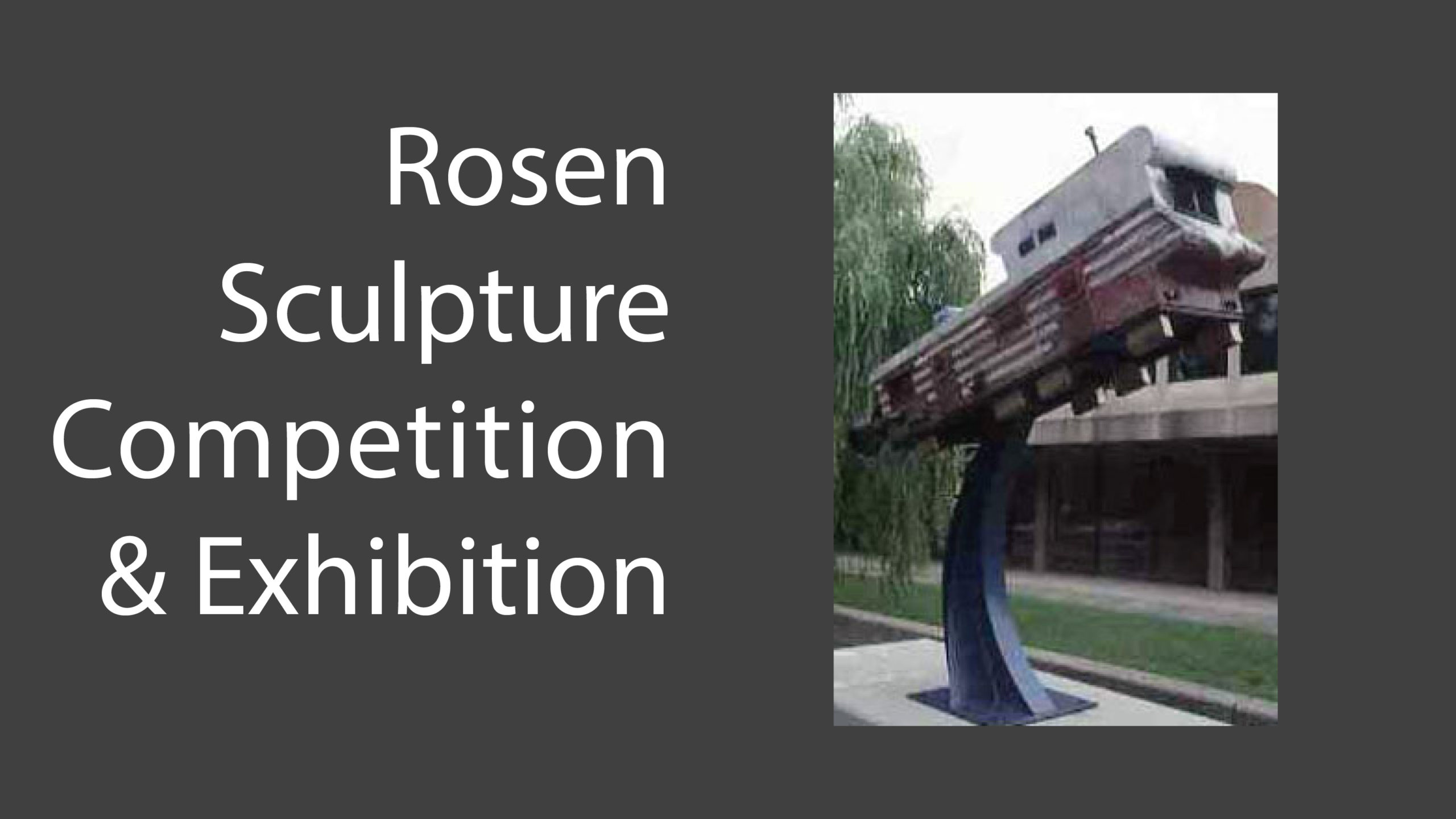
Robbie Barber, Goddard Nomad V. 1994 /8th Rosen Sculpture Competition Winner.
Sculptures
-
Goddard Nomad V1st Place
-
OracionPatron's Award
Goddard Nomad V
Robbie Barber
Waco, Texas
Steel. 8′ x 9′ x 2′ 6″
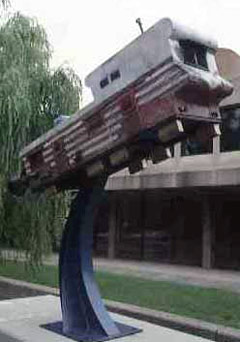
Artist statement
Influenced by literary science fiction, toy design, and American folk art, I use my rural southern heritage as a point of departure to create fantastic hybrid images. For example, with Goddard Nomad V, a mobile home is transformed into a spacecraft of dubious reliability, and reminds us of the American tragedy involving the space shuttle Challenger. An homage to the ingenuity of rocket pioneer Robert Goddard, this sculpture was built in Roswell, New Mexico, where Mr. Goddard practiced his theories.
Having been raised in North Carolina, the southern landscape and the images provoked by this landscape are very important to me. I am fascinated with the strong character and sense of history prevalent in southern dwellings. Architectural monuments such as tobacco barns, house trailers, and feed mills reflect an agrarian way of life that is fading out of existence because of inevitable social and economic changes. Therefore I am compelled to deal with this change in a visual sense. With this in mind, I try to create work that will pay homage to this way of life.
In conclusion, I want my work to be seen as both raw and sensuous, funny yet serious. By this layering effect, I hope the viewer reacts to the imagery in a way that will force the re-evaluation of that imagery.
About the artist
Robbie Barber is currently Associate Professor of Art at Baylor University in Waco, Texas. Born in Williamston, North Carolina in 1964, he was raised on a farm near the Roanoke River in Martin County. He received his BFA degree from East Carolina University in 1987 and his MFA degree from the University of Arizona in 1991. He has gained notoriety as a sculptor working in a variety of media, and is the recipient of numerous awards. These include a North Carolina Arts Council Fellowship and a Southern Arts Federation/NEA Fellowship in Sculpture. He has exhibited at the Grace Museum in Abilene, Texas, Socrates Sculpture Park in Long Island City, New York, the Roswell Museum and Art Center in Roswell, New Mexico, the Rocky Mount Art Center in Rocky Mount, North Carolina, and Grounds For Sculpture in Hamilton, New Jersey, to name a few.
For more information, visit robbiebarber.com.
Oracion
Lyde Zavaleta
Liberty, North Carolina
Welded Steel. 8′ x 7′ x 4′
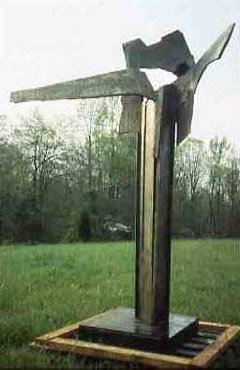
Artist statement
The word “oracion” signifies a creative meditation in the fusion and synthesis of an idea of harmony between the two basic elements of the self: body and spirit. Oracion defines self reflection and meditation on the transient moment of this state of completeness of the being. The sculpture becomes just one means to hold the viewer in this moment of awareness and recreation of inner self and spirit from inside out.
Antagonistic Voyeurism
Fred Zahn
Westville, Ohio
Wood, Steel, and Bronze.12′ x 8′ x 8′
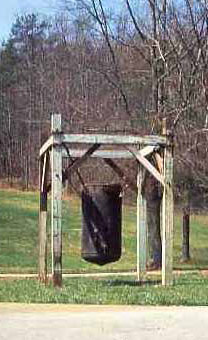
Artist statement
As a sculptor, I am interested in the creation not just of objects, but also of contemplative and provocative spaces. The work is geared toward the uninitiated rather than just the art sophisticate. In the pursuit of making connections and calling up emotion in a viewer/participant, the selection and use of materials is at least as importnat as the creation of objects and spaces. The structures involved in my outdoor work are built from basic elements. Large wood posts and beams, large steel vessels, large steel nuts and bolts, chains, and bronze bells are all materials with certain inherent characteristics that are both rural and industrial in nature. The turn-of-the-century quality in the detail of these materials mixes with the structure to establish a tone with the viewer. The tone (or mood) also acts as a filter that affects perception and amplifies the energy of subsequent interaction within the space and aparatus of the sculpture. Viewers are asked to work with what has been provided. They are encouraged to look at it, move in and around it, shake it, hang on it, ring it and, eventually, feel it. The dialogue the viewer establishes with my work is a central concern of my art-making. I ask the viewer to commit to a certain level of exposure as they explore and interact with what I have made. They draw attention to themselves as they enter an open space, walk gingerly across an elevated platform, or ring a bell, and this element of their own display is meant not only as an interaction/dialogue but also a performance, and possibly vicarious exhibitionism. Personal experiences are filtered through this common environment. This affect creates a marked effect on the viewer and they become the final completing element of the composition.
Barrier or Portal
James A. Florschutz
Newfane, Vermont
Wood and Stone. 7′ 3″ x 6′ 9″ x 1′ 9″
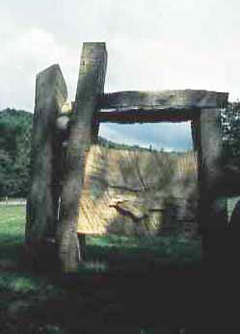
Artist statement
For me sculpture is a language, not of the reasoning mind, but of the soul in touch with nature and our heritage. I see art as the universal communication spanning the boundaries of society, culture, as well as time. Throughout the ages there have been archetypical symbols, myths and sites which strike a chord deep inside of us. As an artist, I have sought to awaken a similar response.
A celebration of nature is central to all of my pieces. The natural world has been not only the source of my materials and forms, but the wellspring of my inspiration. I work with the inherent shapes of the individual pieces of wood and stone – nothing is forced or bent artificially.
I have always had a great fascination in ancient cultures and past civilizations. Through my sculpture I have explored and interpreted archaic symbols, form(at)s, and rituals. My work is in part an evocation – a memory from a time when art and life were one. I try to awaken in people a sense of the mysterious and sacred. This awareness is very ancient and yet still alive – in all of us.
Bulbous
Rob Lorenson
Dekalb, Illinois
Auto Tires. 8′ x 4′ 8″ x 4′ 8″
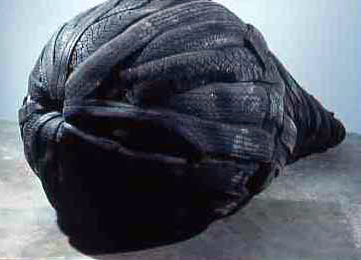
Artist statement
My work in this exhibition represents a series of pieces that utilizes automobile tires as a sculptural media. The work reflects my interst in the inherent qualities of materials. Pattern, texture and color are used in their natural state and are altered as little as possible.
The form of the shape is meant to relate to the natural curved shape of the material. All of this results in a reordering of this material or object that is a part of our everyday existence.
Chalice II
Alvin Frega
Castle Hayne, North Carolina
Steel. 6′ x 3′ x 3′
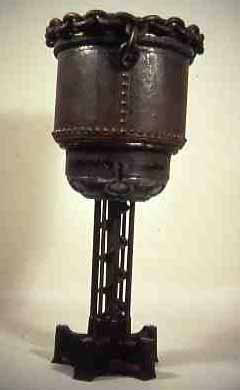
Artist statement
In all cultures, water and its receptacles have been insistent images and powerful symbols, perhaps because water has always been man’s most basic need. In Eastern cultures (Egypt, India, China), water is considered the elemental substance, the source of all life – limitless, formless, embracing all actuality and potential. In the West, this symbolism often identifies itself with unfathomable and impersonal wisdom. Immersion can signify rebirth or healing.
Because water is both formless and precious, its containers have motivated many beautiful symbols. In pagan and Christian cultures, the chalice provides both a receptacle for the formless substance of life and a symbol of receptivity and striving. The most complicated of all chalice legends is the story of the grail. According to legend, a mysterious symbolic illness has stricken the ancient king, the keeper of the grail’s secret. All of nature is wilting like the King himself; the animals die and the trees give no fruit. No physician can cure the king until Sir Pursifal asks him, “Where is the Grail?” Instantly, the monarch rises, healed, and all of nature flourishes around him.
The chalice is not only one of the most ancient of the symbols of healing, it further represents our quest for health. The circular form of the vessel signifies unity in the timeless quest, much like the round table where the legendary seekers of the grail sat to show their solidarity, equality, and willingness to sacrifice on their search for the source of well being.
The chalices I create are formed of industrial found objects. These works are highly polished, at times almost ceremonial, yet are compiled of forms that have their own recognizable industrial history. That industrial objects assume so naturally their place as art pieces and symbolic forms is, I believe, a sign of the fertile, thriving nature of our modern sensibility. Although we labor mechanically, our quest for strength, wisdom, and health are not much different from the ritualistic searches of our ancestors.
Homage to Fido
Tim Curtis
Iowa City, Iowa
Steel, Concrete, and Iron. 7′ x 3′ 9″ x 2′ 8″
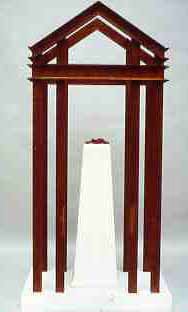
Artist statement
This sculpture is to be seen as a paradoxical comment on humans’ relationships with their pets. The elaborate architectural columns and pediment suggest both shelter, in this case the dog house, and altar. The scale, materials, and height of the structure affirms the inordinate amount of love and money we Americans spend on our pets. The pedestal within this “sacred space” presents the viewer with the backbone of the pet food industry, the almighty dog bone, this time cast not in the traditional bronze but in the rather mundane material iron. The irony lies in the fact that the milk bone from afar doesn’t look much different going in than it does going out.
Vertical Form 93-5
Thomas Sternal
Morehead, Kentucky
Copper and stone. 7′ 5″ x 2′ 8″ x 2′
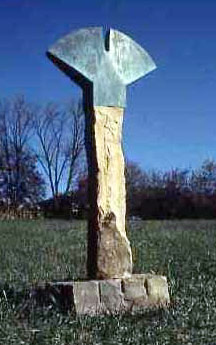
Artist statement
As an artist I am always playing shape against shape, texture against texture and color against color. Starting as a woodcarver I came to realize that the sculptor must collaborate with the material, letting the grain and color lead to the final form. From years of working in wood I have taken the collaboration with the material to stone and even metal fabrications. Now I try to combine materials into shapes that suggest forms that might be naturalistic but ultimately remain quite abstract. Further, I want my sculpture to be as viewer friendly as possible with many being interactive sites for the viewers to act out scenarios. The largest of these pieces often serve as a stage set waiting for actors to perform around and on them. Ultimately, I want the viewer to experience the variety of texture, color and spatial relations that I do as an artist.
Wedged
Roger Halligan
Asheboro, North Carolina
Steel and Concrete. 8′ x 2′ x 2′
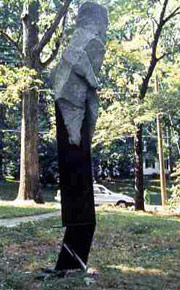
Artist statement
The prehistoric megaliths, especially the pre and early Celtic menhirs, cairns and cromlechs with their corresponding petroglyphs influence and give form to my art. I’ve chosen to focus on these early forms of sculpture, drawing and architecture for inspiration because they simply have such a strong impact on me. The original site specific works: standing a rock up vertically on end; placing stones in a pile or formation and the scratching and smearing with simple tools and pigments, to make marks on the uneven surfaces of a rock in order to signify a place, an event, a belief, remarkably still speak to us with relevance. These forms relate to us silently, signifying concept (i.e. the name, place, celestial events, fertility, life, death, duality, divinity, etc.)
I make my art with steel and concrete mostly. Manmade materials found commonly in our contemporary world. The constraints and freedoms of our culture make these materials as available, accessible and reasonable for me to use as were the rocks used at Neolithic sites like Carnac, Avebury or New Grange. My need and rationale for making these works, I feel, are similar to those of my Celtic ancestors. They are about making a sign post, a holy place, a recording of events, emotions or beliefs. They are made to both activate and interact with the sensual, physical environment we live in as well as to be invitation to those metaphysical and mystical realms our minds can take us to.
Witnesses
Rick Booth
Soddy Daisy, Tennessee
Steel and Brushed Aluminum. 10′ x 8′ x 8′
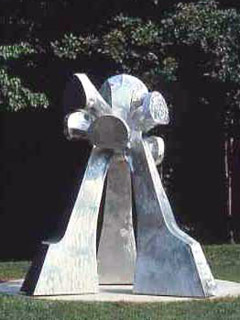
Artist statement
Witnesses was influenced by the organic forms of artists like Henry Moore and Lynn Chadwick. The original idea was conceived in the late seventies, however the outer skin has changed media several times; first it was intended to be ferro-cement, then later cor-ten steel with stainless welds and finally brushed aluminum. The six “heads” face all directions and “see” everything, thus the title Witnesses. Organic flowing work is my favorite because it seems to take on a personality all its own, and stand on its own three feet.
About the juror
Jesus Bautista Moroles is a preeminent American sculptor known for his large scale works in granite and his service on multiple boards and panels throughout the country. Having received numerous awards, as well as both a grant and a fellowship from the National Endowment for the Arts, Mr. Moroles’ work can be found in many public, corporate and private collections.
The artist makes his home in Rockport, Texas near his quarry and studio, and fulfills an ambitious lecture schedule in addition to his studio work. Mr. Moroles’ work was shaped by his education at the University of North Texas in Denton, Texas – where he received his BFA – and a year spent in Pietransanta, Italy.
Mr. Moroles’ exhibition record is comprised of many solo and group exhibitions held across the United States. In addition to his exhibition and lecture schedule, Mr. Moroles has served as artist/instructor for an extensive listing of workshops.
A Special Thanks from the Curator
On behalf of An Appalachian Summer, the Office of Cultural Affairs and the Catherine Smith Gallery I want to express our gratitude to all of the artists who participated in this year’s competition and congratulate those selected for the exhibition. We appreciate their efforts in making these works available to our community during the upcoming year. I wish to offer our sincerest thanks to our juror, Jesus Bautista Moroles, for accepting the difficult challenge of adjudicating this year’s competition and commend him for selecting these outstanding works.
I want to take this opportunity to thank my colleagues in the Office of Cultural Affairs; Perry Mixter, Director; Gil Morgenstern, Artistic Director for An Appalachian Summer; Sali Gill-Johnson, General Manger; Sara Heustess, Box Office Manager for Farthing Auditorium; Greg Williams, Technical Director for Farthing Auditorium; Jim Sigmon, Assistant Technical Director for Farthing Auditorium; Elizabeth Blair, Promotions; Sandra Black, Fiscal Officer; and Barbara Lawrence, Office Secretary. I also wish to acknowledge the support from Clyde Robbins, Assistant Vice-Chancellor for Physical Plant Operations; Larry Bordeaux, Director of Facility Support Services; Terry Beach ASU Grounds Supervisor; Evan Row, Safety Officer; Dr. James Hutchens, Art Department Chairman; and Sherry Edwards, Professor of Art. Their efforts, advice and encouragement in presenting the exhibition is greatly appreciated.
My thanks to those whose skills and talents made this publication possible: Ed Midgett for his excellent work in designing this publication; Hank T. Foreman, Gallery Assistant and John Cushing, Gallery Intern for their many contributions in planning and overseeing the installations of the works on our campus and the production of the exhibitions catalogue.
To all of the above I extend my sincerest gratitude.
-Terry Suhre
